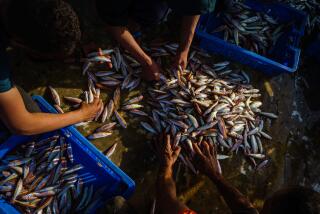The human ‘superpredator’ is unique — and unsustainable, study says
If you’re looking for the world’s top “super-predator,” look no further than your own reflection.
A new study that examined 2,125 interactions between predators and their prey found that humans kill other carnivores at a rate far higher than all other top predators. But what solidifies our No. 1 position is the fact that our hunting methods are so devastating to other species that they alter the course of their evolution — if they’re not driven to extinction.
The findings, published this week in the journal Science, reveal the full extent of the damage wrought by human hunting and fishing practices. The loss of these fearsome carnivores is deeply worrisome to ecologists because top predators play a major role in keeping their ecosystems in balance.
The study also suggests there might be hope for recovery — if we learn to act more like the carnivores we’ve been hunting down.
Many of the world’s top predators on land and in the seas have been on the decline for years, and people have had a major hand in their downfall. Hunting, climate change and human habitat encroachment have all played a role.
Within the last tens of thousands of years, woolly mammoths, saber-toothed cats, giant sloths and other marvelous megafauna roamed Earth, only to begin disappearing around the same time that humans arrived on the scene. Today, species including bears, sharks and tigers are threatened.
To get a better handle on the effect of humans’ hunting, the researchers calculated the rates at which various predators exploited their available adult prey — in other words, the share of the adult population they killed each year.
They found that the human take of adult fish was a whopping 14.1 times higher than the median rate of other marine predators. On land, humans killed top predators at a rate 9.2 times higher than that of other top carnivores.
“We predicted that there would be difference, but we were surprised by the magnitude of that difference,” said study leader Chris Darimont, a conservation scientist at the University of Victoria in British Columbia, Canada.
The finding was all the more shocking considering that the rate at which humans killed these carnivores was 3.7 times the rate at which they killed herbivores.
Human hunters, it seems, specialize in turning other predators into prey.
“Some of these topics have been explored in the past,” said William Ripple, an ecologist at Oregon State University who was not involved in the research. But “the way they quantified it, and the way they put it into context, is striking,” he said.
It wasn’t just the magnitude of the hunt or catch that was the issue. Compared with other successful hunters, humans have a very different — and problematic — hunting strategy that targets strapping adults rather than the younger, smaller or weaker members of a species.
“Typically, human hunters remove 1 in 5 large carnivores from the planet each year,” Darimont said. “That’s kind of spooky,” he added, because the animals can’t produce babies that grow into adults fast enough to sustain their population levels.
And that’s why humans’ propensity to kill adults is so dangerous, Ripple said — our hunting behavior “has ecological implications.”
Think of it from a business perspective: An adult female is the capital, and the young she produces are the interest generated by that capital. If you kill an adult, it will take years for another to grow up and take her place. But if you kill a juvenile, it will take only until the next breeding season to produce a replacement.
Other highly successful hunters, such as fishing birds, tend to pick off more vulnerable members of a species. Smaller prey are easier to catch — and to eat. Although that may not seem sportsmanlike, it allows predators to keep prey populations in balance without wiping them out.
In the case of fish, populations aren’t just dwindling — their demographics are changing. In some cases, when large adults are killed, only smaller ones reproduce. That can mean they lay fewer eggs, and the fish that do hatch are smaller.
The solution, the study authors say, is to fish and hunt more like our fellow predators, who have been hunting sustainably for millions of years. That means sparing the adults and going after the young.
This is a lesson humans have yet to learn, conservation biologist Boris Worm of Dalhousie University in Nova Scotia, Canada, who was not involved in the study, wrote in a commentary that accompanied the paper.
Unlike other predators, humans “have the unusual ability to analyze and consciously adjust our behavior to minimize deleterious consequences,” Worm wrote. That “will prove critical for our continued coexistence with viable wildlife population on land and in the sea.”
Changing the practices of some fisheries may help to bring declining populations back from the brink. But when it comes to animals on land, it’s probably best not to kill them in the first place, Darimont said.
“Large carnivores are so sensitive to habitat disturbance and human activity that they’re best left alone if we want future generations to see them,” he said.
Among other things, Darimont recommended compensating livestock owners when one of their animals is killed by a predator so that there’s less incentive to find and kill the offending meat-eater.
And instead of allowing trophy hunting, it could be just as lucrative for countries to promote wildlife ecotourism.
“You can make as much or more money from shooting large carnivores with cameras, not guns,” he said.
Twitter: @aminawrite





